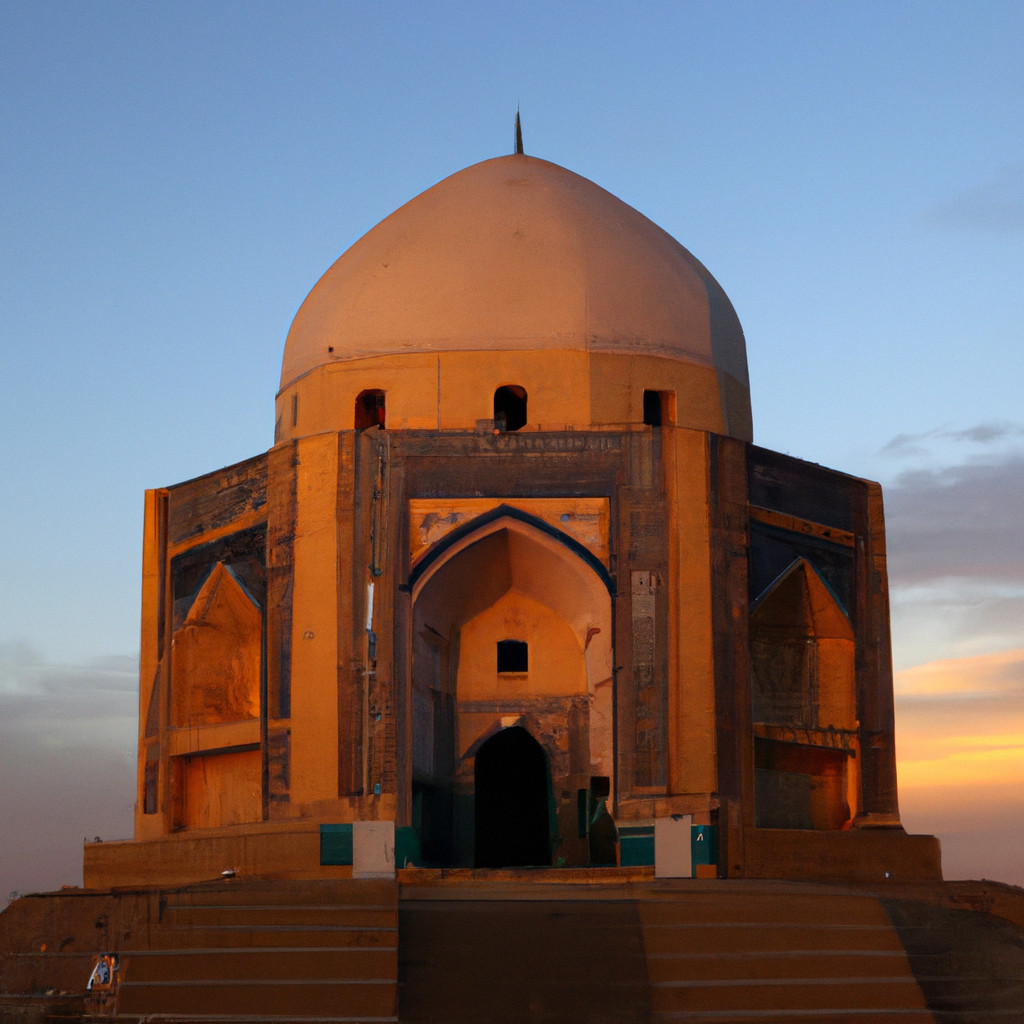Sufi Sahib Mausoleum in Farah City, is one of many fascinating sites that both foreign visitors and local tourists can explore while they visit Afghanistan and exploring Farah Province.
This quiet and serene spot is steeped in history, having witnessed centuries of change. It was here that many spiritual figures found their final resting place and numerous historical figures paid homage, including Sufi Sahib himself. Many local people and tourists from different parts of the world visit this site to pay their respects, and to experience the vibrant history and unique spirituality that imbues this tranquil setting. The Sufi Sahib Mausoleum is not simply a place of death, but a place of life, culture, and a testament to the enduring spirit of Afghan history.
Sufi Sahib Mausoleum Most Important Events
- Construction of the Mausoleum: An influential occurrence in the Mausoleum’s history is its own creation. The Mausoleum was built centuries ago on the serene outskirts of old Farah City, creating a venerated place of honors and respect for revered spiritual figures.
- The Pilgrimage of Spiritual Leaders: Over the centuries, many spiritual leaders made pilgrimages to the Sufi Sahib Mausoleum, increasing its reputation as a holy site and a place of spiritual solace. This amplified its standing both locally and across Afghanistan.
- Recognition as a Cultural Heritage Site: In modern times, the acknowledgment of the Sufi Sahib Mausoleum as a cultural heritage site marked a significant development. This not only secured its preservation but also its recognition as an important site of Afghan history and culture.
History of Sufi Sahib Mausoleum in Farah City
Dating back to a time steeped in legend, the Sufi Sahib Mausoleum has seen the rise and fall of many eras. The Mausoleum’s initial construction is believed to have been during the time of the pre-Islamic dynasty and it has remained a constant presence ever since. Lorries of traders, caravans of pilgrims, and armies of invaders have passed by this site, each leaving their own mark on its history.
However, it was during the Islamic Golden Age that the Mausoleum truly flourished. This was a time of great cultural, intellectual, and economic growth in the region. Scholars and Sufis from far and wide traveled to the Mausoleum, seeking knowledge, spiritual enlightenment, and a place of peace and respect.
In recent years, the Mausoleum has seen a revival, with increased efforts to preserve its antiquity. The government has recognized its historical importance, and locals and international bodies alike are working to maintain the Mausoleum’s legacy.
Why It’s Important to Afghan History
The significance of the Sufi Sahib Mausoleum in Afghan history lies not only in its spiritual importance but also in its role as a symbol of Afghanistan’s rich cultural heritage. It stands as a testament to Afghanistan’s past, a repository of collective memory, and a marker of continuity amid change.
Its importance is also deeply spiritual. The Mausoleum is a place where ordinary people and scholars alike have sought solace for centuries. It represents Afghanistan’s spiritual heart, making it an essential part of Afghan history.
Why to Visit Sufi Sahib Mausoleum
The Sufi Sahib Mausoleum is a journey to a past rich in history, abundant in spiritual significance, and filled with architectural beauty. The Mausoleum, with its tranquil surroundings, forms a serene contrast to the bustling modern world, becoming a haven for those seeking peace.
In addition to its historical and spiritual allure, the Mausoleum offers stunning vistas. One can immerse themselves in the natural beauty surrounding the Mausoleum, where lyrical landscapes and serene sunsets provide a mesmerizing backdrop.
- Experience the tranquility of the Mausoleum.
- Explore the rich Afghan history and heritage.
- Embrace the beautiful surrounding landscapes.
- Witness the architectural beauty of the Mausoleum.
- Experience local traditions and customs first-hand.
The Mausoleum is easily accessible from Farah City. It’s best visited during the mild weather of spring or autumn when the landscape is at its most picturesque.
Cultural & Tourist Significance
The cultural significance of the Sufi Sahib Mausoleum is inextricably linked to its influence on Afghan history, social customs, and religious practices. For centuries, the Mausoleum has served as a spiritual hub, a place where historical figures, scholars, and Sufis congregated.
Furthermore, in the area surrounding the Mausoleum, one can experience local traditions and customs first-hand. You can engage with natives, try local cuisine, and immerse yourself in the local culture’s essence. It is an experience that you can’t find in guidebooks, but is felt and lived.
From a tourist perspective, the Sufi Sahib Mausoleum offers a unique experience, blending awe-inspiring archeology, invigorating spirituality, and captivating history. It’s more than just a sightseeing spot; it’s a living testament to Afghanistan’s cultural tapestry.
Interesting Facts
Over the years, anecdotes and legends about the Mausoleum have been passed down through generations. Tales of miraculous healings and stories of spiritual revelations are just a part of the mystique surrounding this revered site.
Moreover, it’s often said that a visit to the Mausoleum brings the visitor a unique sense of inner peace. This powerful emotion is believed to last long after the visit and can lead to personal transformation.
Lastly, the resilience of the Mausoleum is itself an intriguing fact. Despite the turmoils it has witnessed, the Sufi Sahib Mausoleum stands firm, a testament to its enduring significance.
In summary, the Sufi Sahib Mausoleum is a fascinating blend of history, culture, and spirituality. It’s a cornerstone of Afghan heritage, a reminder of its diverse and colorful past. Whether you’re a historian or a traveler seeking unparalleled experiences, it promises an enriching journey into Afghanistan’s heart.


